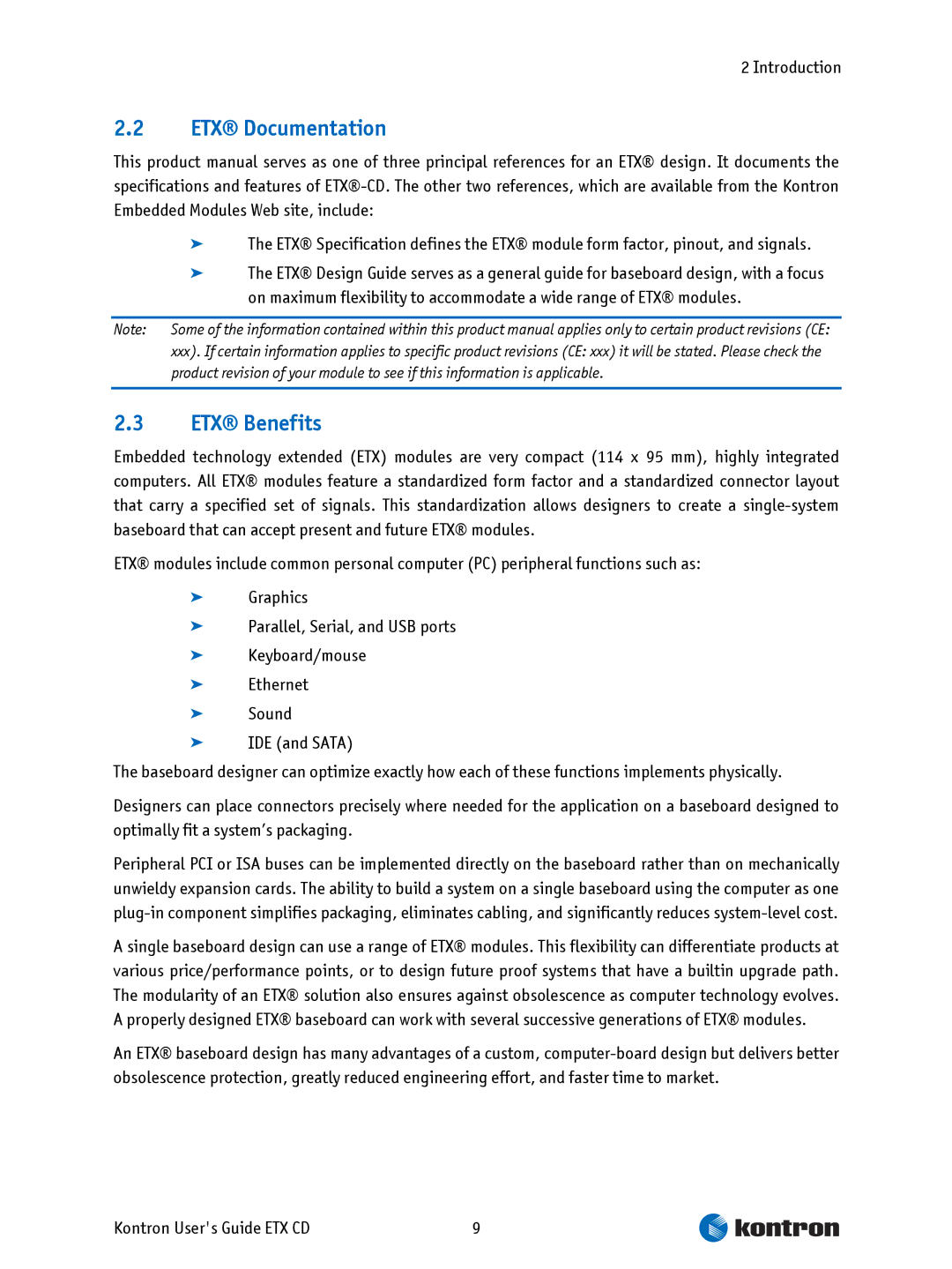Document Revision All not approved entries are marked
ETX CD
This page intentionally left blank
Table of Contents
Kontron Users Guide ETX CD
Connector X4 IDE 1, IDE 2, Ethernet, Miscellaneous
10.2
10.1
10.2.1
10.3
User Information
Asia Europe North/South America
Technical Support
ETX-CD
Introduction
Introduction
2x Serial ATA Sata 1x Parallel ATA IDE
ETX Benefits
ETX Documentation
Functional Specifications
Specifications
Serial Digital Video Output Sdvo Intel 945GM
System Memory
PCI 32 Intel ICH7
Enhanced Intelligent Drive Electronics Eide Intel ICH7
Bios Phoenix, 1MB Flash-BIOS in Firmware Hub Flash Memory
AC ’97 Audio Intel 945GM
Trustes Platform Module TPM
Block diagram
Electrical Specifications
Mechanical Specifications
Power Consumption Windows XP SP2
Cmos Battery Power Consumption
ETX-CD Core Duo Processor T2500
Temperature
Environmental Specifications
Mtbf
Humidity
Specifications
Connector Locations
ETX connectors
General Signal Description
ETX connectors
Pin Signal
Connector X1 PCI bus, USB, Audio
Connector X1 Signal Levels
Pin 1-50 Power PCI USB Audio
Pin Signal Description Type Termination Comment
Pin 51-100 Power PCI USB Audio
Pin Signal Description
Type Termination Comment
3V Power Supply for External Components
Connector X1 Signal Description
PCI Bus
Audio
Connector X2 ISA Bus
Pin 1-50 Power ISA
Connector X2 Signal Levels
Pin 51-100 Power ISA
ISA Bus Slot
Connector X2 Signal Description
Flat-Panel Interfaces
Lvds Interface Pinout Jili
Parallel Port / Floppy Interfaces
Parallel Port Mode Pinout Floppy Support Mode Pinout
DCD1# SLCT# WGATE# DSR1# Msclk CTS1# Msdat TXD1 Kbclk
Pin 1-50 Power VGA Lcdtv
Connector X3 Signal Levels
Pin 51-100 Power COM LPT Floppy KB/MS/IR
VGA Output
Connector X3 Signal Description
Serial Ports 1
PS/2 Keyboard
IrDA
Parallel Port
Floppy
Connector X4 IDE 1, IDE 2, Ethernet, Miscellaneous
Connector X4 Subsystems
Pin 1-50Power IDE Ethernet Power control Misc
Connector X4 Signal Levels
Pin Signal Description Type
Power Control
Connector X4 Signal Description
Power Management
IDE Ports
Sdvo Connector and Flat Foil Cable
Feature Connector J11
Sdvo Output
Miscellaneous Circuits
Bios Requirements
Pinout Feature Connector J11
Pin Pin on ETX-CD Description
Reserved
Watchdog Timer
Special Features
Special Features
Configuration
Design Considerations
Heatspreader Dimensions
Thermal Management
Design Considerations
Page
I/O Apic vs 8259 PIC Interrupt mode
Important Technology Information
Thermal Monitor and Catastrophic Thermal Protection
Processor Performance Control
Summary
Active Cooling
Schematics of Fan control
ETX-CD onboard Fan connector
Passive Cooling
Critical Trip Point
Pinout Kontron Users Guide ETX CD
Location and Pinout of Fan connector J6
Bios Settings
Electrical characteristics
Vcc = Imax continuous = 68 a Imax pulsed =
Processor Clock Throttling
Acpi Suspend Modes and Resume Events
Page
8259 PIC mode
System Resources
Interrupt Request IRQ Lines
Direct Memory Access DMA Channels
Apic mode
Used For Available Available for PCI Comment
I/O Address Map
Memory Area
Peripheral Component Interconnect PCI Devices
Inter-IC I2C Bus
JILI-I2C Bus
ISA Bus
Limitations
Windows
Limitations
Determining the Bios Version
Bios Operation
Setup Guide
Start Phoenix Bios Setup Utility
Displaying Submenus
Selecting an Item
Item Specific Help Window
General Help Window
Info Screen
Bios Setup Menus
Main Menu
Disabled
Auto
IDE Channels Submenu
Advanced
Advanced Chipset Control
CPU Control
Feature bit to always return
Chipset control
Default
Dvmt
Integrated Video
ISA Options
Other
PCI/PNP Configuration
PCI/PNP ISA UMB Region Exclusion
PCI/PNP ISA IRQ Resource Exclusion
Write Protect
Cache Memory
Device Configuration
Lan Options
IRQ4
Super I/O Controller Options
USB ports
Console Redirection
30/sec
Keyboard Features Submenu
Hardware Monitor
Watchdog Settings
CRT + LFP
Display Control
Miscellaneous Submenu
Security Menu
Yes
Power Menu
POR
CPU Thermal Control Circuit
Feature Option Descpription
Boot Menu
Exit Menu
Feature Description
Cannot flash when memory managers are present
Updating or Restoring Bios
Preventing Problems When Updating or Restoring Bios
Appendix a Jida Standard
Jida Information
Appendix a Jida Standard
Appendix B PC Architecture Information
12.1.1 ISA, Standard PS/2 Connectors
Buses
12.1.2 PCI/104
12.2.1 RS-232 Serial
Ports
Serial ATA
12.2.3 USB
Kontron Users Guide ETX CD
Appendix C Document Revision
Appendix C Document Revision
Rev. Date Author Changes
